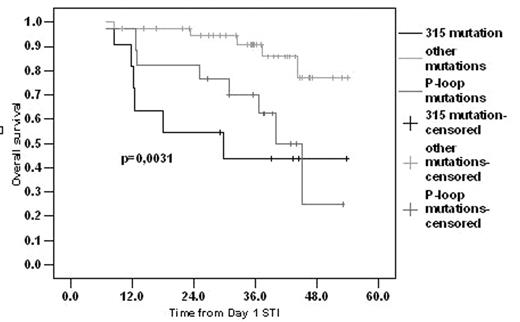Abstract
Imatinib mesylate (IM) is highly effective in newly diagnosed CML. Unfortunately, acquired abl-kinase domain mutations are commonly identified to be associated to resistance or relapse in patients with advanced disease. Distinct mutation exhibit varying degrees of resistance, and mutation occurring in the ATP-binding loop (P loop) or in positions in direct contact with IM (i.e. T315) may be correlated with subsequent disease progression.
In this study, we investigated the bcr-abl mutation status of imatinib-resistant CML patients and correlated to the disease outcome.
Patients and methods: From CML patients diagnosed in 5 French centers, 67 IM-resistants patients presenting mutations by direct sequencing of the abl kinase domain at time of resistance or relapse were included in this study. When starting IM monotherapy (J1) at 400 to 600 mg per day, 45 patients were in chronic phase of CML, 12 patients were in accelerated phase of the disease and 7 patients were in blast crisis. The median duration of IM is 29 months (range 3–54) and the median delay between diagnosis and J1 is 34 months (range 0–168). At the end of the study, 23 patients were dead. According to the mutation status, a Kaplan-Meier curve was construct for time to death to J1, and survival were compared using log rank test.
Results: By direct sequencing, 17 patients presented mutations in the P-loop (residues 252 to 255), 10 patients presented the T315M mutation alone, 1 patient had the T315 and the M351 mutations, and 39 patients presented mutations in other kinase domains. According to the mutation status, survival difference between patients presenting P-loop mutations or mutations in an other abl-kinase (including T315), no significant difference was observed (p=0.07). However, survival difference between patients presenting P-loop mutations, T315 mutation and mutations in an other abl-kinase domains was highly significant (p=0.0031, figure). The median survival for the P-loop and T315 mutated patients was of 39 months and 29 months respectively, and median survival not reached for others.
Conclusion: By this study we confirm that either the T315 mutation or mutations in the P-loop had a poor prognosis. Detailed correlation analysis of mutation status according to clinical features and response to increased IM-dose will be reported.
Author notes
Corresponding author


This feature is available to Subscribers Only
Sign In or Create an Account Close Modal